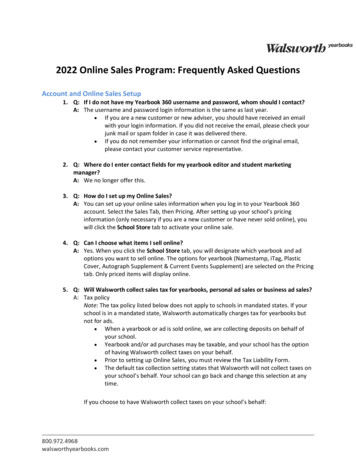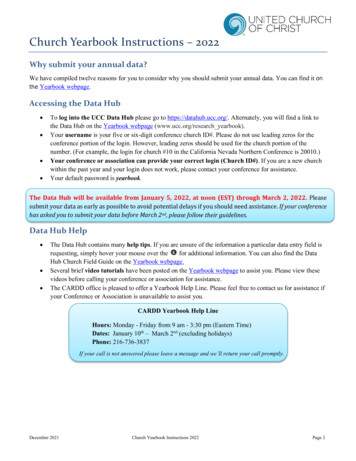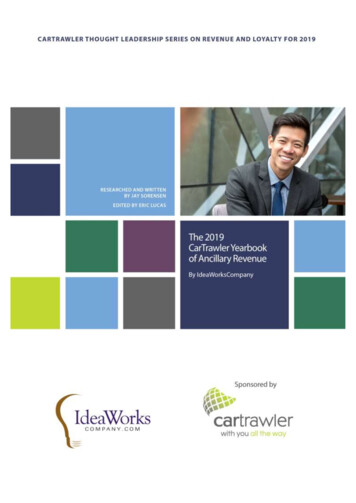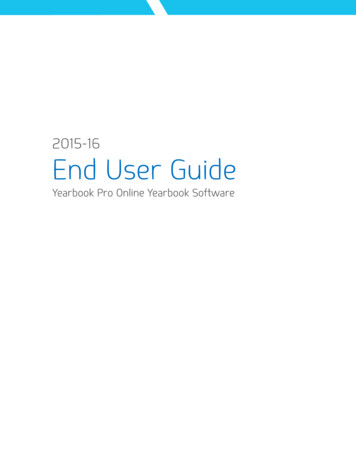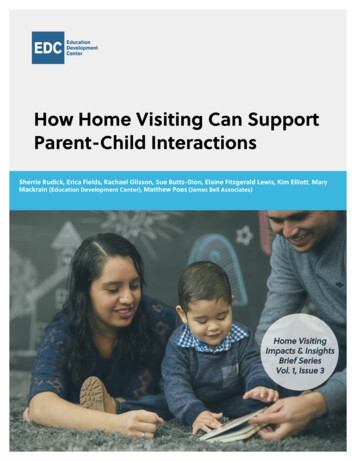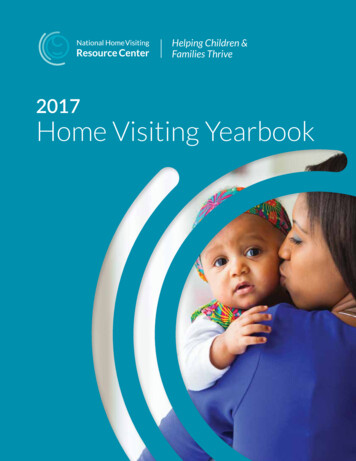
Transcription
Helping Children &Families Thrive2017Home Visiting Yearbook
PREFACEIt is easier to buildstrong children thanto repair broken men.— Frederick Douglass22017 HOME VISITING YEARBOOK
PREFACEAbout the National Home VisitingResource CenterThe National Home Visiting Resource Center (NHVRC) is a source forcomprehensive information about early childhood home visiting; itsgrowing evidence base; and its potential impact on children, families,and communities. The center’s goal is to support sound decisions inpolicy and practice to help children and families thrive.In 2017, its inaugural year, the NHVRC will— Publish original products, including the 2017 Home Visiting Yearbook Build an online collection of home visiting resources and research Create a space to share professional and personal experiences with home visitingJoin the conversation at nhvrc.org2017 HOME VISITING YEARBOOKi
PREFACEAcknowledgmentsThe 2017 Home Visiting Yearbook was developed by James Bell Associateswith the Urban Institute. Support was provided by the Heising-SimonsFoundation and the Robert Wood Johnson Foundation. The viewsexpressed here do not necessarily reflect the views of the foundations.A number of people contributed their time and expertise to the Yearbook, which was producedunder the general direction of Jill Filene and Allison Meisch of James Bell Associates and JuliaIsaacs and Heather Sandstrom of the Urban Institute. We acknowledge the contributions ofother members of the NHVRC team, including Courtney Harrison, Alexandra Joraanstad,Doreen Major Ryan, Kassie Mae Miller, Joelle Ruben, Charmaine Runes, and Mariel Sparr.Invaluable support was provided for data collection, data management, and consultation byother NHVRC staff, particularly Matthew Poes, Mallory Quigley, and Kerry Ryan.We also acknowledge the expert feedback and guidance provided by our Advisory Committeemembers: Moushumi Beltangady, Deborah Daro, Nicole Denmark, Anne Duggan, DiedraHenry-Spires, Annette Wisk Jacobi, Carlise King, Lauren Supplee, Jeffrey Valentine, andDavid W. Willis. We are grateful for the support of our partners at the Heising-SimonsFoundation (Holly Kreider, Liane Wong, and Deanna Gomby) and the Robert Wood JohnsonFoundation (Claire Gibbons).Special thanks are due to the families and home visiting staff who graciously shared theirstories to help bring the Yearbook data to life. We appreciate the efforts of the representativesfrom states, territories, and tribes who participated in interviews and shared data. We are alsograteful for the representatives from home visiting models who shared their data and time withus in interviews. The Yearbook would not have been possible without their support.We are grateful to Forum One for design and production services and to Ann Emery of EmeryAnalytics for data visualization expertise.ii2017 HOME VISITING YEARBOOK
PREFACEPermission to copy, disseminate, or otherwiseuse information from this report is grantedwith appropriate attribution to James BellAssociates and the Urban Institute.Suggested CitationNational Home Visiting Resource Center.(2017). 2017 Home Visiting Yearbook.Arlington, VA: James Bell Associates and theUrban Institute.2017 HOME VISITING YEARBOOKiii
EXECUTIVE SUMMARYExecutive SummaryThe 2017 Home Visiting Yearbook compiles key data on early childhood home visiting, aproven service delivery strategy that helps children and families thrive. Home visitinghas existed in some form for more than 100 years, paving the way to a healthier, safer,and more successful future for families. It connects parents-to-be and parents of youngchildren with a designated support person who guides them through the early stages ofraising a family. For many, it is a bridge to becoming the kind of parents they want to beso they can unlock their child’s potential.Home visiting is voluntary and tailored to meet families where they are—from a teenage single mother in Phoenixto an expectant military couple near the Smoky Mountains to a Native American woman raising a grandchildwith special needs in North Dakota. Depending on the family’s circumstances, the home visitor might talkwith them about their child’s developmental milestones, coach them in positive parenting, connect them withneeded services, and even help them create a resume so they can find a job. Home visiting is cost effective, withdemonstrated improvements in child health, well-being, and school readiness and parent self-sufficiency.Home visiting is offered in many communities, perhaps even yours. The 2017 Home Visiting Yearbook presents,for the first time, the most comprehensive picture available of home visiting on the national and state levels. Itreveals the breadth of home visiting across America but also the gaps, where families in need are going withoutthis vital source of support. To produce the Yearbook, the National Home Visiting Resource Center examinedpublicly available data, collected new data, and analyzed what we found.There are so many barriers to receiving the help you might need,whether it’s transportation, childcare We take all of those barriersout of it. [Parents and caregivers] can be sitting on their couch, theirkids can be playing with toys. They can bring their books. I think thatgives them a sense of ease as we begin to talk.Chris Margard, home visitorPhoto courtesy of Matthew Johnson/Urban Instituteiv
EXECUTIVE SUMMARYHighlights More than 18 million pregnant women andfamilies (including more than 23 million children)could benefit from home visiting. More than a quarter of a million families receivedevidence-based home visiting services in 2015over the course of more than 2 million home visits. States have long supported home visitingservices by pooling limited resources. Theyallocate federal dollars and state funds fromtobacco settlements and taxes, lotteries, andbudget line items. Some foundations provideadditional funding. Home visiting is provided atno cost to recipients. Through the Maternal, Infant, and Early ChildhoodHome Visiting Program (MIECHV), the federalgovernment has bolstered evidence-based homevisiting since 2010, investing 1.85 billion forservices, research, and local infrastructure todevelop early childhood systems. Evidence-based home visiting is nowimplemented in all 50 states, the Districtof Columbia, 5 territories, and 25 tribalcommunities. About 40 percent of all countieshave at least one local agency offering evidencebased home visiting. The field is moving toward professionalization ofthe home visiting workforce to standardize andsupport the knowledge and skills needed to servefamilies successfully. The evidence base for home visiting is strong andgrowing.The Yearbook is based on the best information available but reflects limitations associated with the lack of astandard reporting mechanism for home visiting. Our data are therefore incomplete and underestimate thenumber of families served.In future years, we will expand the story of home visiting, even as that story continues to unfold in innovativeways across the country. We will work with models and states to collect the most complete data possible. Wewill also keep listening. We want to understand what other questions need answers, what emerging issues needattention, and what new and essential information the field needs to achieve its goals.Read on to discover the state of early childhood home visiting in America today and a vision for what it could be.Use the Yearbook to make informed decisions about home visiting in your program, agency, community, or state.Share it widely. Keep the conversation going. Let us know what you think.2017 HOME VISITING YEARBOOKv
INTRODUCTIONIn this report1Introduction2Chapter 1A Primer on Early Childhood HomeVisiting16Chapter 2The Early Childhood Home VisitingNational Landscape34Chapter 3The Early Childhood Home Visiting LocalLandscape: States, Territories, and Tribes38Take-Home Messages42Appendicesvi2017 HOME VISITING YEARBOOK
INTRODUCTIONIntroductionRecent years have brought an unprecedented expansion of early childhoodhome visiting. Together, states and communities have made new inroadsimplementing home visiting models that improve outcomes for childrenand families. The value of home visiting is increasingly documented andrecognized. Yet there has been no comprehensive picture of how homevisiting is playing out across the country.The 2017 Home Visiting Yearbook shares reliable, objective information to inform sound decisionsin policy and practice. It asks critical questions, including the following: Where do home visiting programs operate? How many families and children are being served by home visiting, and how many morecould benefit? Who develops and administers home visiting? Who funds home visiting?This first edition of the Yearbook presents a snapshot of home visiting using the most complete dataavailable. It looks at the national landscape of home visiting and then drills down to the states. TheYearbook relies primarily on agencies in states, territories, and the District of Columbia (hereafterreferred to as states) that have received funds through the federal Maternal, Infant, and EarlyChildhood Home Visiting Program (MIECHV) and organizations that have developed home visitingmodels that are recognized as evidence based.1 It also draws on public data sources such as theHealth Resources and Services Administration and the U.S. Census Bureau.The National Home Visiting Resource Center (NHVRC) acknowledges that the service data presentedhere are not complete because of the lack of a standard reporting mechanism for home visiting. Fordetails about our mixed-methods approach, which included both qualitative and quantitative data, seeappendix 1. In future Yearbooks, we will seek to expand and improve our data collection efforts.The Yearbook defines evidence-based home visiting as programs that have met rigorous U.S. Department of Health andHuman Services criteria for evidence of effectiveness as determined by the Home Visiting Evidence of Effectivenessproject (HomVEE).12017 HOME VISITING YEARBOOK1
CHAPTER ONEA Primer on EarlyChildhood HomeVisitingThis chapter serves as an introduction to early childhoodhome visiting, providing context for the data presented later inthe Yearbook. It presents— Background information that defines home visiting and outlinesits history Highlights from the evidence base for home visiting, describing itsdemonstrated impact on critical needs An overview of the funding sources for home visiting services2
A PRIMER ON EARLY CHILDHOOD HOME VISITINGWhat Is Home Visiting?Few experiences are as rewarding and challenging as parenthood. Manyparents still remember the friends and relatives they turned to for advice afterdiscovering they were expecting a child. Unfortunately, not everyone has a builtin system to help them navigate a child’s early years.Early childhood home visiting is a service delivery strategy that matches new and expectant parentswith a designated support person—typically a trained nurse, social worker, or early childhood specialist.Services are voluntary and provided in the family’s home or another location of the family’s choice,often reaching socially or geographically isolated families.A two-generation approach, home visiting delivers both parent- and child-oriented services to help thewhole family. It views child and family development from a holistic perspective that encompasses— Child health and well-being Parent health and well-being Child development and school readiness Family economic self-sufficiency Positive parent-child relationships Family functioningHome visiting can benefit all families that welcome a child into their lives. For families facing additionalstressors, such as unemployment or health concerns, a consistent lifeline can provide the stability theyneed to get back on their feet. Home visitors get to know each family over time and tailor servicesto meet its needs. A home visit might include an assessment of child and family strengths and needs,provision of information on child developmental stages and progress, structured parent-child activities,family goal setting, assistance addressing crises or resolving problems, coordination with neededcommunity services, or emotional support during stressful times.iHome Visiting: A Brief HistoryEarly childhood home visiting is not new. As early as 1883, private charities sent home visitors to provideguidance and model healthy behaviors to the urban poor.ii Over time, new professions were created tosupport families in the home. The Settlement House movement of the early 1900s propelled the ProgressiveEra in the United States, promoting visiting nurses, teachers, and social workers.iii Federal interest in theneeds of mothers and young children led to the passage in 1935 of Title V, the Maternal and Child HealthProgram (which was later converted to a block grant). In the 1960s, the War on Poverty increased awarenessof early child care and child development.42017 HOME VISITING YEARBOOK
A PRIMER ON EARLY CHILDHOOD HOME VISITINGIn the early 1970s, C. Henry Kempe, a crusader for the prevention of child maltreatment, advocated for auniversal approach to prevention through a network of home health visitors.iv Influenced by this approach,modern home visiting began with Hawaii’s implementation of the Healthy Start Project in 1975.v In 1977,David Olds initiated the first randomized control trial of what would become the Nurse-Family Partnershipmodel, marking the beginning of rigorous evidence building in home visiting.vi Political and community supportfor home visiting also began to gather and, bolstered by state and foundation funding, led to the creation ofthe first Parents as Teachers program in 1981.viiThe bourgeoning development of home visiting models continued throughout the 1990s. In 1992, HealthyFamilies America emerged from the National Committee to Prevent Child Abuse (now Prevent Child AbuseAmerica),viii with funding support from Ronald McDonald Children’s Charities (now Ronald McDonaldHouse Charities). Critical to the design of Healthy Families America was the development of infrastructureto replicate the model, including training, technical assistance, and an accreditation system to assessimplementation. This laid the groundwork for the national expansion of home visiting models a decadelater. Models also emerged from practice communities and academic settings, including Minding the Baby,which began in 2002 as a collaboration of the Yale Child Study Center, Yale School of Nursing, Fair HavenCommunity Health Center, and Cornell Scott-Hill Health Center.ixIn the new millennium, several models established national offices, and six of the largest models collaboratedto create a national forum.x Its focus was to improve home visiting and develop benchmarks for measuringquality. In 2009, the U.S. Department of Health and Human Services (HHS) established the Home VisitingEvidence of Effectiveness project (HomVEE) to review the evidence base for home visiting models.xiBipartisan support for evidence-based home visiting led to the creation of the Maternal, Infant, and EarlyChildhood Home Visiting Program (MIECHV) in 2010. Five years later, MIECHV funding was reauthorizedthrough 2017.Bipartisan support forevidence-based homevisiting led to MIECHV.2017 HOME VISITING YEARBOOK5
A PRIMER ON EARLY CHILDHOOD HOME VISITINGHome Visiting: A Timeline18991970sMary Richmond publishes her manual forhome visiting, “Friendly Visiting Among thePoor: A Handbook for Charity Workers.”C. Henry Kempe proposes home healthvisiting to prevent child abuse and neglect.619351975Congress passes Title V, the Maternaland Child Health Program.Hawaii implements the HealthyStart Project.1960s1977The War on Poverty emphasizes supportfor early child care and development.David Olds beginsrandomized clinical trialsthat lead to Nurse-FamilyPartnership.1900–1920s1974Settlement houses for the urban poorare expanded.Congress passes the Child Abuse Prevention andTreatment Act.2017 HOME VISITING YEARBOOK
A PRIMER ON EARLY CHILDHOOD HOME VISITING19812009The Missouri Department ofEducation designs first Parents asTeachers program.HHS launches HomVEE to review theevidence base for home visiting models.19942011Head Start expands homevisiting to children from birth toage 3 (Early Head Start).Pew Charitable Trusts hosts thefirst National Summit on Qualityin Home Visiting Programs.20002015National Home Visiting Forumconvenes for first time.Congress reauthorizesMIECHV fundingthrough 2017.19922010Healthy Families America isestablished.Congress invests 1.5 billion in homevisiting through MIECHV.2017 HOME VISITING YEARBOOK7
A PRIMER ON EARLY CHILDHOOD HOME VISITINGEvidence-Based ModelsHome visiting models vary based on factors such as their target audience, the outcomes they prioritize,and the duration and frequency of home visits. As of June 2017, 20 home visiting models met rigorousHHS criteria for evidence of effectiveness, as determined by HomVEE (see NHVRC Model Profiles): Attachment and Biobehavioral Catch-Up Healthy Families America (HFA)*(ABC) Intervention Child FIRST* Early Head Start-Home Visiting (EHS)* HealthySteps2 Home Instruction for Parents of PreschoolYoungsters (HIPPY)* Early Intervention Program for Adolescent Maternal Early Childhood Sustained HomeMothersVisiting Program (MECSH) Early Start (New Zealand) Minding the Baby* Family Check-Up for Children* Nurse-Family Partnership (NFP)* Family Connects* Oklahoma’s Community-Based FamilyResource and Support (CBFRS) Program3 Family Spirit* Health Access Nurturing DevelopmentServices (HANDS) Program* Healthy Beginnings Parents as Teachers (PAT)* Play and Learning Strategies (PALS)* SafeCare Augmented** Designates the 13 models that met HHS criteria for evidence of effectiveness and were operating in theUnited States in 2015, the year for which data are reported in this Yearbook. HomVEE reviews are ongoing.During a recent update, HomVEE revised the HealthySteps profile to include changes to the model, noting home visiting is notHealthySteps’ primary service delivery strategy. States could implement HealthySteps with MIECHV funds in fiscal years 2014 and 2015but could no longer do so beginning in fiscal year 2016.2Oklahoma’s Community-Based Family Resource and Support Program is no longer in operation. See https://homvee.acf.hhs.gov/models.aspx for details.382017 HOME VISITING YEARBOOK
A PRIMER ON EARLY CHILDHOOD HOME VISITINGWhy Home Visiting?The first 5 years of life are the building blocks for children’s future health,development, and academic achievement.xii In fact, children’s earlyexperiences and interactions with adults shape brain development andserve as the foundation for subsequent learning.xiii, xiv, xv Early childhoodhome visiting empowers parents and caregivers to meet their family’s needsand to engage more fully in their children’s care and growth. The resultsare improved outcomes and positive returns on investment for adults andchildren alike.Home visiting has a strong evidence base, with many studies showing that it works.4 As a twogeneration approach, home visiting has the potential to improve outcomes across a range ofdomains, such as child health, school readiness, parent economic self-sufficiency, and parentingpractices. Not all domains have been well studied or have demonstrated improvement across allhome visiting models.5 Here we highlight examples of home visiting’s demonstrated impact oncritical needs.xvi, xvii4For more comprehensive reviews of the evidence base for home visiting, see Solving Social Ills Through Early ChildhoodHome Visiting, retrieved from y-childhood-home-visiting and Components Associated with Home Visiting Program Outcomes: A Metaanalysis, retrieved from https://www.ncbi.nlm.nih.gov/pubmed/24187111.For details about models by outcome domain, see evidence reviews conducted by HomVEE, Home Visiting EvidenceEffectiveness: Outcomes, retrieved from https://homvee.acf.hhs.gov/outcomes.aspx52017 HOME VISITING YEARBOOK9
A PRIMER ON EARLY CHILDHOOD HOME VISITINGHealthy BabiesAccess to prenatal care prevents birthcomplications for both infants and mothers andreduces health care costs.xviii Unfortunately,national data reveal that not all babies get ahealthy start:6 Six percent of expectant mothers haddelayed or no prenatal care.xix Ten percent of infants were bornprematurely.xx Approximately 6 percent of infants diedbefore age 1.xxiSafe Homes and NurturingRelationshipsPreventable injuries and abuse happen all toofrequently to children in the United States: Nineteen percent of children under 18 visitedthe emergency room because of accident orinjury between 2010 and 2013.xxiv Unintentional injuries were a leading causeof death and disability among children aged1–4.xxv The rate of substantiated child abuse was9 per 1,000 children under 18, with themajority of victims under age 1.xxviHome Visiting as Part of the SolutionHome Visiting as Part of the SolutionHome visitors work with expectant and newmothers to ensure optimal care in pregnancyand infancy. Indeed, pregnant home visitingrecipients are more likely to access prenatal careand carry their babies to term.xxii Home visitingalso promotes infant caregiving practices likebreastfeeding, which has been associated withpositive long-term outcomes related to cognitivedevelopment and child health.xxiiiHome visitors provide parents with knowledgeand training to make their homes safer. Forexample, educating parents about how to “babyproof” their home can reduce unintentionalinjuries. Home visitors also teach parents how toengage with their children in positive, nurturing,and responsive ways, thus reducing childmaltreatment.xxviiData presented in this section are from 2014 unless otherwise indicated. For national and state data about maternal and child healthindicators of well-being, see appendix 2.6102017 HOME VISITING YEARBOOK
A PRIMER ON EARLY CHILDHOOD HOME VISITINGOptimal Early Learningand Long-Term AcademicAchievementBecause the early years of life are critical tobrain development, parent-child activities likereading together are linked to future academicachievement. Nationally, many children do notget the start they need to launch a positiveacademic trajectory: Sixty-four percent of fourth graders failedto meet standards for reading proficiencyin 2015.xxviiiSelf-Sufficient ParentsMany people do not have the education andjob opportunities they need to successfullynavigate the transition to parenting andadulthood: For 14 percent of children under 18, thehead of household had less than a highschool diploma. For another 45 percent of children under 18,the head of household had only a high schooldiploma.xxxi Approximately 3 in 10 children under age18 lived in families where no parent hadregular, full-time employment.xxxiiHome Visiting as Part of the SolutionHome Visiting as Part of the SolutionHome visitors offer parents timely informationabout child development, helping them recognizethe value of reading and other activities forchildren’s learning. This guidance translates toimprovements in children’s early language andcognitive development, as well as academicachievement in grades 1 through 3.xxix, xxxHome visitors help parents set goals topromote their financial self-sufficiency. Thissupport translates to better education andemployment outcomes. Compared with theircounterparts, parents enrolled in home visitinghave higher monthly incomes, are more likely tobe enrolled in school, and are more likely to beemployed.xxxiii, xxxiv, xxxv, xxxvi2017 HOME VISITING YEARBOOK11
A PRIMER ON EARLY CHILDHOOD HOME VISITINGStrong Return on InvestmentStudies of the cost-effectiveness of homevisitingxxxvii show yields of 1.80 to 5.70 forevery dollar invested.xxxviiiFor example, home visiting can reduce child emergency room visits,lowering health care expenses.xxxix It can help identify developmentaland social-emotional delays so children can access services early,lowering future mental health and special education costs.xl Among adultparticipants, outcomes include higher employment rates and tax revenues,reduced criminal activity, and reduced reliance on welfare programs.xli Thisstrong return on investment is consistent with established research onother types of early childhood interventions.xlii122017 HOME VISITING YEARBOOK
A PRIMER ON EARLY CHILDHOOD HOME VISITINGMy mom was only 15 when I was born. My father was convicted of murder shortlyafterwards. I grew up in a housing project in Sarasota, Florida. The odds were reallyagainst me succeeding.Even now at 28 years old, one thing I remember from my childhood is HIPPY. Mymom has told me through the years how the HIPPY home visitor would coach her.Then my mom would do the math and reading lessons with me.I am grateful to this day that my mom cared and took the time to get this help formy benefit.Thanks to HIPPY, I graduated from high school and from college. Today, I amteaching, coaching football, mentoring young men, and helping out at the United WayResource Center.Leroy Butler, former home visiting participant and current board member forHome Instruction for Parents of Preschool Youngsters (HIPPY)Photo courtesy of Leroy Butler2017 HOME VISITING YEARBOOK13
A PRIMER ON EARLY CHILDHOOD HOME VISITINGHow Is Home Visiting Funded?Early childhood home visiting is provided to recipients at no cost tothem. Agencies blend dollars from funding sources at the federal, state,and local levels to cover the cost of services. MIECHV has provided asignificant boost of federal funding for evidence-based home visiting,but MIECHV awardees and other agencies that operate home visitingprograms seek diverse funding streams to reach the many more familieswho could benefit.Aside from MIECHV, states may allocate federal dollars toward home visiting from Title Vof the Maternal and Child Health Block Grant Program, Temporary Assistance for NeedyFamilies, Medicaid, Healthy Start, and the Community-Based Child Abuse Prevention Program.For example, prior to first receiving MIECHV funds in 2010, Louisiana combined state generalfunds, federal maternal and child health dollars, Medicaid dollars, and Temporary Assistancefor Needy Families funding to support implementation of the Nurse-Family Partnership model.xliiiFor decades, states have also drawn on a mix of general and dedicated funds to support homevisiting, including tobacco settlements and taxes, lotteries, and budget line items. Funding is madeavailable through health, education, and human services agencies.States, local agencies, nonprofit organizations, and research institutes also leverage private dollars todevelop, implement, and expand home visiting services. Examples of organizations that support or havesupported home visiting include the United Way, March of Dimes, and philanthropic partners such asthe Robert Wood Johnson Foundation, Heising-Simons Foundation, W. K. Kellogg Foundation, Richard W.Goldman Family Foundation, Pew Charitable Trusts, and others.142017 HOME VISITING YEARBOOK
A PRIMER ON EARLY CHILDHOOD HOME VISITINGAbout MIECHVSince 2010, Congress has invested 1.85 billion through MIECHV to helpstates expand and implement evidence-based home visiting. MIECHV dollarscontribute to service delivery and help build the infrastructure needed tosustain home visiting. These investments strengthen system integration andworkforce development. Three percent of MIECHV funds are designated fortribal awardees.MIECHV is committed to evidence; it requires state awardees to devotethe majority of funds toward implementing evidence-based models. Threepercent of MIECHV funds are set aside to further bolster the home visitingevidence base through research and evaluation. Awardees must also monitorand report on performance.xlivThe number of families served by MIECHV programs quadrupledbetween 2012 and 2015. In 2015, MIECHV state awardees served— Twenty-six percent of all counties Twenty-nine percent of urban counties Twenty-three percent of rural countiesxlv
CHAPTER TWOThe EarlyChildhood HomeVisiting NationalLandscapeThis chapter presents national data about homevisiting. The data come from evidence-based models,state agencies, and public data sources.The service data are based on the best information available but are not complete.States have great flexibility in using blended funding streams to implement homevisiting models that meet local needs. There is no standard reporting mechanism forhome visiting across models and states outside of MIECHV. Some models and states wereunable to respond to our requests for data or could provide only partial data. And althoughMIECHV is an important funding source and a key driver of evaluation and innovation, thereare many local and promising home visiting programs funded by other sources that we wereunable to include.Despite these limitations, the national landscape portrayed here tells the most complete story yetabout home visiting. It presents— Information on where home visiting programs operate The number and characteristics of families and children who are served by home visiting The number and characteristics of families and children who could benefit from home visiting Information about the home visiting workforce16
THE EARLY CHILDHOOD HOME VISITING NATIONAL LANDSCAPEWhere Do Home Visiting Programs Operate?Exhibit 1. Evidence-Based Home Visiting by County (2015)Counties with at least one evidence-based home visiting modelCounties without evidence-based home visiting
THE EARLY CHILDHOOD HOME VISITING NATIONAL LANDSCAPEEvidence-based early childhood home visitingprograms operate in all 50 states, the District ofColumbia, and 5 territories.Home visiting is also provided to
EECUTIVE SUMMARY iv Executive Summary The 2017 Home Visiting Yearbook compiles key data on early childhood home visiting, a proven service delivery strategy that helps children and families thrive. Home visiting has existed in some form for more than 100 years, paving the way to a healthier, safer,




